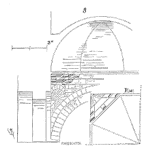
This article explains the metal corrosion process including the basic chemistry of how metal loss occurs. Methods to control corrosion are also listed and explained.
The Corrosion Process
Metal corrosion is a chemical reaction between a metal surface and its environment. Corrosion can occur in a gaseous (dry) environment or a damp (wet) environment. Figure 1 shows the behaviour at the atomic level of both dry and wet environmental corrosion.
Corrosion in a gaseous environment produces a surface layer of converted metal. For example atmospheric corrosion of zinc produces the dull, gray zinc oxide layer seen on galvanised street light poles. Unoxidised zinc coating fresh from the hot dip galvanisers is bright and shiny.
Corrosion in a wet environment attacks the metal by removing the atoms on the metal surface. The metal atoms at the surface lose electrons and become actively charged ions, which leave the metal and enter the ‘wet’ electrolyte. The metal ions join with oppositely charged ions from another chemical and form a new, stable compound.
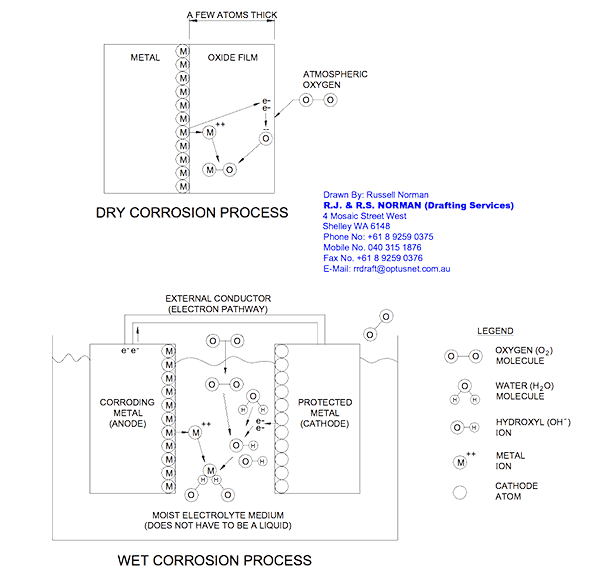
Corrosion requires energy. During corrosion the reacting components go from a higher to a lower energy state and release the energy needed for the reaction. In the dry corrosion process of Figure 1 the metal and the oxygen combine to produce the oxide on the surface because the reaction leads to a compound (oxide) at a lower energy level.
The oxide layer shields the metal from the oxygen and forms a barrier. The oxide will not react with the oxygen in the air or the metal. The barrier makes it difficult for oxygen in the air to contact the metal and it eventually grows so thick that the movement of electrons and ions across it stop. Provided the oxide layer does not crack, or is not removed, the metal is protected from further corrosion. But if the bare metal is exposed to the oxygen it will again react to form the oxide. In this case the presence of oxygen benefits the metal’s protection. Removal of the oxygen removes the metal’s ability to create its own protective corrosion barrier.
In the wet corrosion process of Figure 1 the electrons from the corroding anode metal move to the connected cathode where they recombine with the atoms of oxygen and water in the electrolyte to make a new hydroxyl ion (OH-). This new negatively charged ion then reacts to make a stable compound with the positively charged metal ions (M++) that originally lost the electrons. In this case the electrons have a continuous pathway to escape the parent metal and the parent metal, which cannot develop a protective barrier, disassociates or falls apart. Once corrosion starts it continues until the ingredients are all used up.
The electrolyte in wet corrosion can be neutral, acidic or alkaline. For corrosion in near neutral solutions (pH 6 – 8) under oxygenated conditions the predominant cathodic reaction is the oxygen absorption reaction (O2 + 2H2O + 4e- = 4OH-) shown in Figure 1. If instead the bimetallic cell has no oxygen present in the electrolyte the hydrogen evolution reaction (H+ + e- = H followed by H + H = H2 gas) becomes the cathodic process and the anode continues to corrode. This reaction is a much slower reaction (the H+ ion has a very low concentration in solution) than the oxygen absorbing reaction. In acidic solutions (pH 0 – 6) the hydrogen ion concentration is higher and the hydrogen evolution reaction is the predominant one. Corrosion rates become extreme as the pH drops (acid gets stronger).
The Electrical Nature of Corrosion
A flow of electrons means there is an electric current. Wet corrosion produces a corrosion cell. Much like a car battery. The electrons used in creating the corrosion product are continually replaced from the corroding metal. The numbers of electrons available for reacting control the amount of current developed between the two metals. The anode cannot corrode unless there is a cathode. One of them will control the rate of electron flow and thus the corrosion rate.
The intensity (the number of electron and positive ion pairs) is dependent on the potential difference, or voltage, which exists between the metals and the surface area of each metal. Different metal combinations have different voltage potentials between them. Joining two metals with a large potential difference between them produces higher corrosion rates than if the metals were close in electrical potential.
Surface Area Effects
The size of the cathode relative to the anode is important. A large cathode has more surface area through which electrons can flow and so develops an intense electric current with the anode (corroding metal). A small anode connected to it is forced to supply these electrons and will quickly corrode and fall apart. Whereas a large anode connected to a small cathode can provide electrons from any location and will take a long time to show evidence of corrosion.
Where a less noble (base, anodic) metal has to be in contact with a noble metal make sure the less noble metal has at least one hundred times more surface area than the noble metal. Remember – large anode, small cathode – not the opposite.
Differential Aeration Effects
The corrosion reaction requires oxygen and where oxygen is present the metal is cathodic and where oxygen is depleted the metal is anodic and corrodes. The parts of the metal in contact with the highest oxygen concentration become cathodic and are protected, and the areas where oxygen concentration is low will corrode. Steel posts dug into the ground will rust just below the surface because of this effect.
Stagnation Effects
During corrosion, ions build up immediately around the anode and cathode saturating their respective regions. The corrosion rate begins to fall due to the concentration of stagnant ions blocking the creation of more ions in the electrolyte. If the ions are removed or more voltage is provided the corrosion rate again picks up. If you want fast corrosion then agitate the electrolyte and add oxygen.
Specific Types of Corrosion
Corrosion produces physical evidence of its presence. The form it takes depends on the mechanism of the corrosion. Some of the more common forms are explained below.
Pitting Corrosion
A metal can corrode without being in contact with another metal. In this case different areas of the metal take on different electrical potentials. This can occur because of variations in the metal metallurgical properties or because of variations in the surface oxide layer, such as a break, thinning, inclusion like mill scale, contaminant like dirt, etc.
In pitting corrosion the metal at the top of the pit has access to the oxygen in the air and becomes the cathode. At the bottom of the pit oxygen is depleted and the metal becomes the anode. The deeper the pit is the less the oxygen available at the bottom and the corrosion rate increases. Figure 2 shows the mechanism of pitting corrosion.

Crevice Corrosion
A crevice is created whenever two objects are brought together. Unless they are perfectly flat a crevice results and oxygen cannot enter the gap but is plentiful outside. Corrosion starts in the crevice because of differential aeration. Figure 3 is a drawing of crevice corrosion occurring under a layer of seawater.
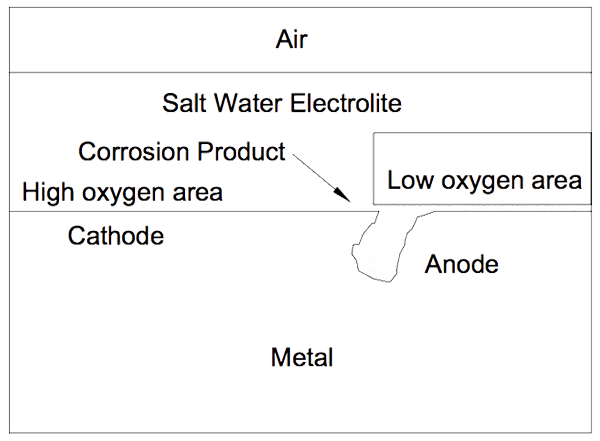
Stress Corrosion
Metal under tensile stresses can corrode at higher rates than normally expected. The stressed areas have changed electrical potentials to the neighbouring metal and are also more likely to develop microscopic surface cracks. Both situations promote increased corrosion rates.
Galvanic Corrosion
Galvanic corrosion needs to be watched. Dissimilar metals of different potentials joined together by an electrolyte, like process water or rainwater, will cause the more anodic metal to corrode. Running copper water pipe to a galvanised tank will cause the tank to corrode very quickly. Joining copper to steel is nearly as bad. In the galvanic series listed in Table 1 only join metals that are near each other.
Some protection from galvanic corrosion can be achieved if the electrolyte is not present. Without the availability of water molecules the corrosion reaction stops because the electrons cannot find a host to complete the chemical reaction. Where dissimilar metals must be used, for example aluminium fins on the copper coils of a refrigeration chiller condenser, protect them from contact with water. If water must be used in contact with dissimilar metals insure it is deionised and oxygen free.
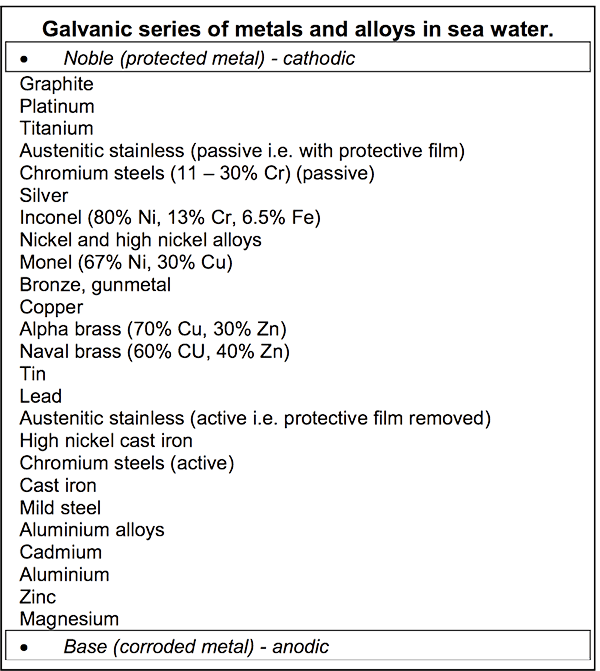
Table 1. The Galvanic Series (Part) in Seawater Electrolyte.
Bacterial Corrosion
There exist many species of bacteria living in moist environments that release acidic waste products or that can strip out elemental components of a metal. If these bacteria grow on pipe walls and metal surfaces they will cause corrosion. They occur in both oxygenated (aerobic) and oxygen free (anaerobic) conditions.
Controlling Corrosion
Corrosion control involves hindering the natural chemical reactions that occur between the metal and its environment. The common methods used are to:
- Modify the environment,
- Modify the properties of a metal,
- Install a protective coating over the metals,
- Impose an electric current to supply electrons,
- Change to non-metallic materials.
Modify the Environment
Removing oxygen from the environment prevents completion of the corrosion process by slowing the chemical reaction requiring electrons. If oxygen can be kept away from the protected cathode then the electrons cannot readily flow, so causing the current to drop and corrosion to slow.
Another technique is to use corrosion inhibitors that combine with the corroding metal (anode) or the protected metal (cathode) to form a barrier layer that reduces the flow of ions and electrons to very low values, which virtually stops the corrosion. If the protective barrier layer is damaged corrosion restarts, so it is necessary to keep an amount of the inhibitor in contact with the metals.
Modify the Properties of the Metal
From the galvanic series we can see that the more noble metals are less likely to corrode. When these metals are combined with those from lower in the series, the resulting alloy takes on corrosion resistant properties. The resistance can come from the development of a protective oxide film on the outside surface or because the new alloy has a different voltage potential which acts to make it behave more noble.
Passivation of a metal is a method of changing the potential difference of a metal’s surface. By removing the oxide layer normally present on a metal and exposing the bare metal directly with an acid, the acid reacts with the metal surface to make a new compound with more noble electrical properties. The passivated layer covers the metal, and provided the layer is not broken and the voltage potential remains favourable, it will protect the metal under it from corrosion.
Put Protective Coating Over the Metal
Metals can be protected by covering them in a coating of a different material with better corrosion resistant properties. Metallic and non-metallic coatings are used.
Metallic coatings of less noble metal over more noble metal provide sacrificial protection. Galvanising is a bonded, protective coat of zinc put over steel. The zinc protects the steel from corrosion in two ways. From the galvanic series it can be seen that zinc will corrode before steel (sacrificial). Secondly, a protective layer of zinc oxide forms on the zinc. If the oxide layer is scratched the zinc is exposed to oxygen and the oxide layer reforms. If part of the zinc coat is lost the rest of the bonded zinc starts to corrode in preference to the steel. As long as the zinc remains in contact with the steel it corrodes sacrificially and protects the steel.
Non-metallic coatings put over a metal can be of two types. They can act as a physical barrier and bar access to the metal surface or they can introduce a very high resistance into the corrosion cell circuit and drastically reduce the flow of electrons. The barrier type coatings protect the metal as long as there are no cracks. If a crack occurs corrosion becomes intense at the metal surface. Resistance type coatings include additives that breakdown in the presence of water and oxygen into inhibiting agents.
Impose an Electric Current
Wet corrosion produces a bi-metallic cell and an electrical current of moving electrons flow from the less noble, anodic metal. If instead the electrons were supplied from another source the less noble metal would not corrode first. This technique is known as cathodic protection. By connecting a more anodic metal into the corrosion circuit than the metal to be protected, the more anodic metal will corrode first and provide an alternate source of electrons. This is why zinc blocks are placed on ship hulls to protect any steel in contact with seawater.
Alternatively a metered electrical current from a power source can be connected to the cathode to supply the electrons. Figure 4 shows cathodic protection installed on a below ground pipeline using sacrificial anodes that require regular replacement as they are corroded away.
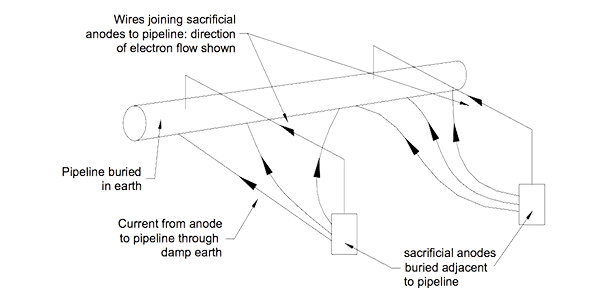
Change to Non-Metallic Materials
There are many other materials that can be used instead of metals in situations where metallic corrosion is expected. Provided the physical properties of the non-metal are satisfactory their use may prove a more effective choice.
Practice to Adopt to Reduce Corrosion
- Clean out debris from the bottom of metal sumps exposed to the atmosphere to prevent oxygen depletion under the debris.
- Repair any damage to painted surfaces quickly to seal the metal off from atmospheric oxygen and moisture.
- Don’t create galvanic cells by mixing metals. Check the
galvanic series when ordering equipment and parts to
see if components are compatible. Keep them dry. - Check the right type of paint is being used with good
corrosion protective properties. - Grout under base plates completely and finish the grout
at the edges of the lower face. Do not bring it up the
side of the base plate and create a crevice. - Remove a paint blister immediately, clean the metal
thoroughly and repaint to prevent differential aeration. - Before bolting or clamping metals parts together insure they both have a completely protected surface. This can
be with a sacrificial coating or a barrier coating. - Be aware that electric currents can flow for hundreds of meters if parts are joined by an electrolyte. Underground pipes in moist soils need to be protected from bother oxygen depletion and galvanic action from
dissimilar metals anywhere along their route. - Use a generous radius when bending metals to minimise
the creation of internal tensile stresses. - Use deionised, oxygen free water when washing down
components made of dissimilar metals in contact and
dry them off quickly and thoroughly. - Protect underground piping from direct contact with soil
and protect the coating from damage. The smallest penetration to the metal will result in rapid pitting corrosion of the pipe wall. If that is not possible install cathodic protection. Beware that some painted coatings still allow moisture and oxygen through to the metal. Check the corrosion protection properties of the coating.
Mike Sondalini – Maintenance Engineer
If you found this interesting, you may like the ebook Process Control Essentials.
Mike ,good information you have provided .I appreciate the way you have explained in a very detailed manner .I would recommend people to go through this article to understand what and how corrosion takes place and how to fight it.Keep posting such article.
I didn’t realize that wet corrosion is only possible because of the transfer of electrons from the corroding anode metal into the cathode. This makes me wonder who first determined this way of processing and corroding material. It would also be interesting to see what industrial applications there are for this process.